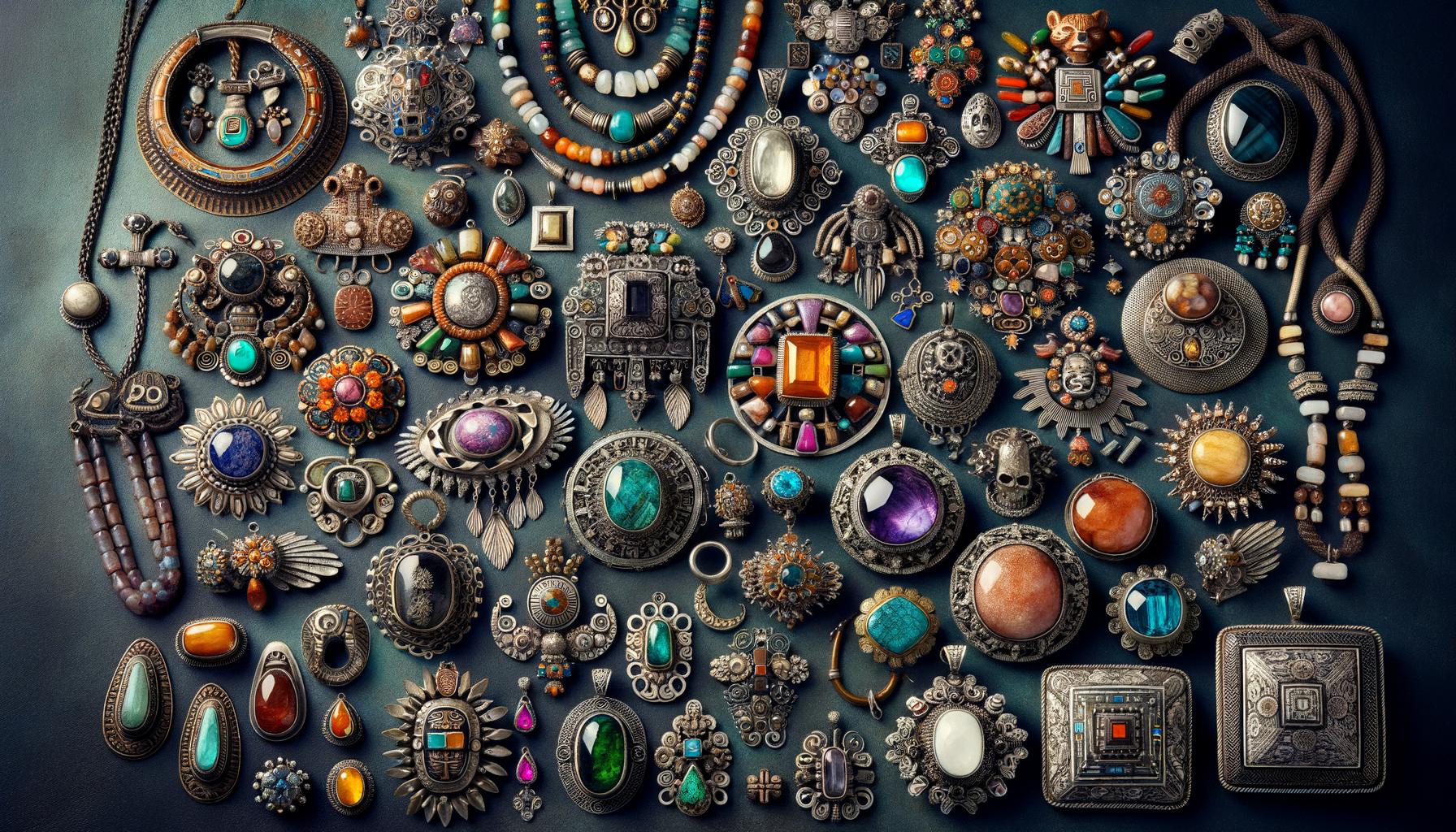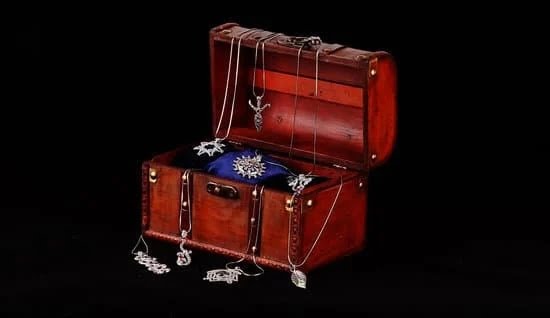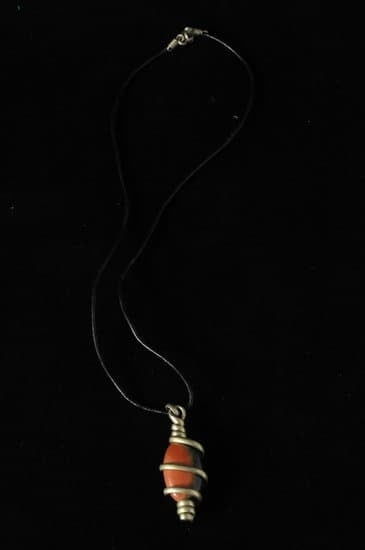Mexican jewelry: a fusion of indigenous and colonial influences, stands out as an artistic embodiment of Mexico’s rich cultural tapestry. This unique form of craftsmanship weaves together the intricate techniques and materials developed by pre-Columbian civilizations with the artistry introduced during the Spanish conquest. Spanning centuries, Mexican jewelry is not just ornamental but deeply embedded in the customs, rituals, and personal expressions of its people.
Jewelry has always occupied a pivotal position in Mexican culture, symbolizing wealth, power, religion, and social status through varying historical periods. From the opulent adornments of ancient Aztec rulers to modern interpretations seen on contemporary runways, it reflects an evolution steeped in tradition yet open to innovation. Mexican communities historically imbued their jewelry with spiritual significance, often incorporating symbols from nature or mythology to convey deeper meanings.
The importance of jewelry in Mexico traverses both time and societal roles-integrating elements that speak volumes about identity and heritage. Modern-day artisans continue this legacy by merging time-honored practices with cutting-edge designs. Thus, each piece is not merely a fashion statement but a chronicle of Mexican history itself-a living testament to centuries-old narratives told through sparkling gems and meticulously wrought metals.
Historical Background
Pre-Columbian civilizations such as the Aztecs, Mayans, and other indigenous societies in Mexico were prolific in their creation of intricate jewelry. These civilizations leveraged the abundant natural resources available to them, crafting awe-inspiring pieces from materials like turquoise, jade, and feathers. Turquoise holds particular significance as it was often linked with religious iconography and believed to possess protective qualities.
Jade, on the other hand, was prized for its green hue symbolizing life and fertility, making it a common choice for royal ornaments and ritualistic items. Featherwork also demonstrated remarkable craftsmanship; vibrant feathers from birds like quetzals were fashioned into exquisite headdresses and necklaces.
The techniques employed by these early artisans were sophisticated for their time. Stone carving, hammering of precious metals extracted from local mines, and beadwork technique showcased a high level of precision and skill. The meticulousness is evident in artifacts unearthed at archaeological sites across Mexico.
The symbolism imbued in these items extended beyond mere decorative purposes; they were imbued with spiritual significance that conveyed status, religious beliefs, and cosmic order within their cultures. Mayan kings wore elaborate jade masks during important ceremonies to reflect their divine status while specific symbols engraved onto jewelry served as talismans meant to invoke protection from various gods.
This rich heritage set the stage for what would become an even more intricate fusion after the arrival of Spanish colonizers in the 16th century. However, it’s essential to recognize that “Mexican Jewelry: A Fusion of Indigenous and Colonial Influences” didn’t merely erase this deeply rooted tradition but rather enhanced it by interweaving European techniques with indigenous expertise.
The introduction of silver filigree work added another dimension to already complex designs resulting in an eclectic mix that we now celebrate as uniquely Mexican.
| Material | Significance |
|---|---|
| Turquoise | Protective qualities; Used in religious iconography |
| Jade | Symbolized life and fertility; used by royalty |
| Feathers | Utilized in vibrant featherwork; indicative of high craftsmanship |
Colonial Influence
The arrival of the Spanish conquistadors in the 16th century marked a significant transformation in many aspects of indigenous life, including jewelry making. The Spanish brought with them a wealth of new materials and techniques that would profoundly influence Mexican jewelry: a fusion of indigenous and colonial influences. One of the most prominent introductions was precious metals such as silver and gold, which were not only more widely used but also refined using advanced European techniques.
During the colonial era, Spanish artisans introduced intricate methods such as filigree, an advanced technique involving delicate twisting and plaiting of fine metal threads to create detailed patterns. This meticulous craftsmanship required high skill levels but provided stunning results that quickly became popular in Mexican jewelry designs. Indigenous craftsmen began incorporating these new techniques into their existing practices, creating pieces that seamlessly blended European sophistication with traditional native symbolism.
A striking look at this cultural amalgamation can be observed in pieces featuring traditional Mexican motifs crafted with European methods. For instance, pre-Columbian symbols of deities or animals might be intricately sculpted using high-quality silver rather than the indigenous materials like jade or turquoise. Some common examples include:
- Amulets depicting Quetzalcoatl, the feathered serpent god
- Ornaments integrating solar imagery prevalent in Aztec culture
- Earrings combining native animal forms with ornate filigree designs
These hybrid creations are quintessential representations of how Mexican jewelry evolved to embody both pre-Hispanic roots and colonial elegance. By fusing indigenous traditions with newly introduced craftsmanship from Europe, artisans forged a unique identity for Mexican jewelry that continues to be celebrated today. Such pieces are prized not just for their beauty but also for their rich historical narrative, encapsulating centuries of cultural exchange and adaptation.
Fusion of Styles
The melding of indigenous and colonial techniques over centuries has led to the creation of a distinct Mexican jewelry style that is instantly recognizable. This fusion resulted in pieces that blend the intricate craftsmanship of pre-Columbian traditions with the refinement introduced by European influences.
For instance, indigenous methods such as featherworking and the use of jade have seamlessly combined with Spanish silver filigree and goldsmithing techniques. This cultural amalgamation essentially birthed timeless designs and led to a new era where Mexican jewelry stood out for its uniqueness and rich history.
Examples vary extensively, from traditional pure forms still used today, like Mayan beaded necklaces, to more hybrid designs that feature baroque pearls set in elaborate silver settings influenced by Spanish artistry. Taxco silver, originating from the town of Taxco in Guerrero, presents one such iconic style that exemplifies this union. With its finely crafted silverwork inspired by both local artistic legacies and Spanish techniques, Taxco pieces are renowned globally for their distinctive elegance and masterful detail.
- Traditional Indigenous Designs: Often featuring turquoise and onyx integrated into beadwork.
- Fusion Styles: Incorporating native stones with European precious metals.
- Contemporary Interpretations: Modern twists on classic themes using mixed media.
Over time, these combined styles assumed deeper roles within Mexican cultural identity. Pieces often serve as symbolic representations of Mexico’s rich history-a physical manifestation of how two drastically different worlds came together to create something entirely new yet deeply rooted in tradition.
These fusion styles are not merely ornamental; they convey narratives of resilience, convergence, and cultural pride. Thus, understanding Mexican jewelry involves appreciating it as much more than just decorative items but rather as sculptures narrating stories through every piece’s intricate details.
Regional Variations in Mexican Jewelry
Throughout Mexico, a wide array of regions contribute uniquely to the rich tapestry of Mexican jewelry: a fusion of indigenous and colonial influences. Each area boasts its own distinctive materials, techniques, and styles that reflect local histories and cultural traditions. Oaxaca, Guerrero, and Chiapas are prominent examples where the craftsmanship of artisans has cultivated regional identities within the broader context of Mexican jewelry.
Oaxaca is renowned for its use of vibrant textiles and intricate beadwork in jewelry design. The region’s artisans draw inspiration from Zapotec and Mixtec heritage, often incorporating motifs like geometric patterns and animal figures into their creations. Traditionally crafted pieces frequently feature native materials such as amber and jade, interwoven with modern elements to produce captivating designs that are both timeless and contemporary.
In Guerrero, particularly in the town of Taxco, silver takes center stage. Taxco is arguably the heartland of Mexican silver jewelry, having developed a reputation since colonial times for its exceptional metalwork. Here, the influence of Spanish settlers introduced new techniques like filigree work which blended effortlessly with indigenous decorative styles. Today’s Taxco silver jewelry remains deeply rooted in this fusion, celebrated for its detailed craftsmanship and elegant designs.
Meanwhile, Chiapas stands out with its emphasis on color-rich materials like jadeite and amber coupled with traditional weaving techniques. Local artisans meticulously integrate these stones into their jewelry pieces, enhancing them with traditional embroidery patterns that reflect the rich Mayan legacy. This unique combination not only preserves Chiapas’ indigenous artistry but also showcases inventive ways to keep tradition alive within a contemporary framework.
These regional variations in Mexican jewelry highlight how different communities across Mexico have contributed distinct stylistic elements to what we now recognize as a cohesive yet diverse spiritual art form influenced by both indigenous roots and colonial legacies.
Symbolism and Meanings in Mexican Jewelry
Common Symbols and Motifs
Mexican jewelry, a fusion of indigenous and colonial influences, is renowned for its rich symbolism and intricate motifs. Common symbols include the Sun, which has been revered in pre-Columbian cultures for centuries as a source of life and energy.
Additionally, representations of pre-Columbian gods are often found in traditional pieces, embodying various aspects of life, nature, and spirituality. Animals also play a significant role in Mexican jewelry design; jaguars, eagles, and snakes are frequently depicted due to their strong cultural ties to strength, freedom, and transformation.
Cultural and Personal Significance
The symbols ingrained into Mexican jewelry go beyond mere decoration-they hold deep personal and cultural significance. For instance, the eagle not only represents power but also resonates with national identity as it is featured prominently on the Mexican flag.
Flowers like marigolds are another symbolic element often worked into jewelry designs; they represent the cycle of life and death which is central to celebrations such as Día de los Muertos (Day of the Dead). Wearing these meaningful pieces allows individuals to connect with their heritage while expressing personal beliefs and values.
Jewelry in Rituals and Ceremonies
Mexican jewelry serves an essential role in rituals and ceremonies across various regions. During weddings, quinceañeras (15th birthday celebrations), baptisms, and other significant events, specific types of jewelry are worn to signify milestones or blessings.
For example, rosaries crafted with unique regional styles might be used during religious ceremonies to invoke protection or spiritual guidance. Additionally, certain beads known as “alebrijes” that combine both mythical creatures from indigenous folklore can be worn during festivals to ward off evil spirits or bring good fortune.
Modern Mexican Jewelry
Contemporary Artists and Their Role in Keeping Traditions Alive
Mexican jewelry: a fusion of indigenous and colonial influences, has transcended time through the dedicated efforts of modern artisans. These contemporary artists skillfully blend ancestral techniques with new creative approaches, ensuring that the age-old practices are not forgotten.
Makers such as Cristina Romo and Ignacio Gomez have imbued their creations with traditional motifs while integrating innovative design elements that speak to today’s audience. This careful balance between legacy and novelty celebrates the rich history of Mexican jewelry while also thrusting it into a vibrant present.
Introduction of Modern Materials and Designs
In addition to preserving ancient methods, modern Mexican jewelers are experimenting with contemporary materials such as recycled metals, acrylics, and other sustainable resources. Designers like Carla Fernández have redefined traditional forms by incorporating unexpected elements that speak both to sustainability concerns and artistic expression.
These fresh materials introduce an exciting dynamism to the art form, creating pieces that reflect current social values while still honoring the past. This evolution ensures that Mexican jewelry remains relevant and respected in today’s global fashion scene.
The Role of Mexican Jewelry in Fashion Today
Mexican jewelry has carved out a prominent place within international fashion circles thanks to its intricate craftsmanship and cultural richness. Renowned designers frequently feature these unique pieces on prestigious runways around the globe, elevating them from mere accessories to statements drenched in historical significance.
Enthusiasts often seek out items epitomizing mexican jewelry: a fusion of indigenous and colonial influences when they desire something both beautiful and meaningful-a testament to Mexico’s enduring impact on world culture. Whether through statement necklaces showcasing vivid indigenous patterns or elegant colonial-inspired silver earrings, modern Mexican jewelry continues to captivate collectors worldwide.
Shopping for Mexican Jewelry
When shopping for Mexican jewelry, it’s essential to recognize the hallmarks that signify authenticity and craftsmanship. Authentic Mexican jewelry: a fusion of indigenous and colonial influences often features a blend of traditional materials like turquoise and jade with the European-introduced silver and gold.
Look for specific trade markings, such as “925” for sterling silver or jeweler’s stamps related to well-known regions, like Taxco. Observing these details ensures you invest in genuine pieces that hold cultural significance and value.
Popular markets and shops provide an excellent starting point for finding authentic Mexican jewelry. In cities such as Oaxaca, Guerrero, and Chiapas, you’ll find bustling markets where local artisans sell their handcrafted works.
These markets are not just centers for commerce but also cultural hubs where you can appreciate the history behind each piece. Shops in these regions often carry items that reflect the area’s unique style-be it bold silver pieces from Taxco or intricate beadwork from Chiapas.
Another crucial aspect of shopping for Mexican jewelry is supporting ethical practices. Make sure your purchase benefits local artisans fairly by buying directly from them or through certified fair-trade shops.
Supporting fair-trade offers multiple benefits: it sustains traditional craft techniques, helps prevent exploitation of artisans, and encourages the continuation of this culturally rich art form. By consciously choosing where to buy your jewelry, you contribute to preserving this unique fusion of indigenous and colonial influences while obtaining beautiful keepsakes.
| Aspect | Details |
|---|---|
| Trade Markings | “925” for sterling silver; artisan stamps |
| Popular Markets | Oaxaca, Guerrero, Chiapas |
| Ethical Considerations | Buy directly from artisans; support fair-trade shops |
Caring for Your Mexican Jewelry
When it comes to caring for your Mexican jewelry, whether it’s a piece resonating with the rich history of indigenous craftsmanship or a celebrated blend showcasing colonial artistry, proper maintenance is crucial. The amalgam of materials such as turquoise, silver, jade, and enamel needs specific attention to maintain its splendor and longevity.
Firstly, regular cleaning plays a significant role in preserving the aesthetic appeal of Mexican jewelry: a fusion of indigenous and colonial influences. Use mild soap and water for routine cleaning, ensuring that any residue from lotions or perfumes does not tarnish precious metals or dull gemstones. A soft brush can be helpful to gently scrub intricate designs without causing damage.
When it comes to storing your pieces, keeping each item in separate cloth pouches can prevent scratching and tangling. Climate control is also essential; store your jewelry in a cool, dry place away from direct sunlight to prevent discoloration and material degradation. Investing in anti-tarnish strips can help keep metals like silver looking their best over time.
Additionally, if your collection includes textiles or featherwork from regions known for unique contributions like Oaxaca or Guerrero, they require specialized care. For instance, avoid exposure to moisture which could compromise organic elements used in these traditional creations. Following these guidelines ensures that your cherished pieces continue to be vibrant embodiments of Mexican culture and artistry for years to come.
Conclusion
Mexican jewelry, with its intricate blend of indigenous and colonial influences, stands as a living testament to the rich tapestry of Mexican culture and history. The fusion of pre-Columbian materials and techniques such as turquoise, jade, and featherwork with the introduced silver and gold filigree methods from Spanish colonizers has given birth to an art form that is both distinctive and deeply symbolic.
This unique amalgamation preserves the spiritual significance that was vital in indigenous traditions while also embracing new styles brought by European settlers. Thus, Mexican jewelry: a fusion of indigenous and colonial influences eloquently captures the essence of a nation’s journey towards forming its own identity.
The regional variations across Mexico further illustrate the diversity within this artistic heritage. Each area-from Oaxaca’s vibrant textiles to Chiapas’ elaborate beadwork-contributes its own flair to the national mosaic of jewelry design. Communities dedicated to preserving these traditional techniques play an invaluable role in maintaining the authenticity and cultural significance of these pieces. As modern artisans continue to innovate by incorporating contemporary elements into their work, they ensure that this historical craft remains relevant today.
In today’s global fashion landscape, Mexican jewelry continues to draw admiration for its beauty and craftsmanship. Whether worn as a statement piece or collected for its historical value, each item tells a story of cultural continuity and adaptability.
By supporting local artisans and seeking out ethically made pieces, consumers can play a part in sustaining this precious heritage. Ultimately, Mexican jewelry reminds us that art is not just an aesthetic pursuit but also a vital expression of identity-and it invites us all to explore and appreciate this extraordinary fusion of cultures.
Frequently Asked Questions
What Is the History of Mexican Jewelry?
The history of Mexican jewelry is deeply intertwined with the rich cultural heritage and diverse influences that have shaped Mexico over centuries. It dates back to pre-Columbian times when indigenous cultures such as the Maya, Aztec, and Mixtec created intricate pieces from materials like jade, turquoise, and gold.
With the arrival of the Spanish in the 16th century, European techniques and designs began to merge with native styles, resulting in unique hybrid forms. Over time, Mexican jewelry has evolved but continues to celebrate its roots through traditional motifs and craftsmanship that reflect both indigenous and colonial heritages.
What Was the Jewelry of the Aztec Civilization?
The jewelry of the Aztec civilization was known for its opulence and symbolic significance. Crafted predominantly from precious metals like gold and silver, alongside semi-precious stones such as turquoise, obsidian, and jade, these items were worn by nobility and high-ranking warriors to denote status and power.
The Aztecs placed great importance on elaborate adornments; their artisans demonstrated exceptional skill in metalworking and stone setting. Jewelry often featured intricate designs including representations of gods, animals, and geometric patterns which held spiritual meanings.
What Did the Aztecs of Mexico Wear as Jewelry?
The Aztecs wore a variety of jewelry as symbols of status, wealth, and religious devotion. Men would don nose plugs or rings made from gold or jade while earrings were common for both men and women. Necklaces often featured strings of beads interspersed with pendants depicting deities or natural elements like feathers or flowers.
Bracelets and anklets made from metals or shells added another layer to their ornate appearance. Above all else stood headdresses embellished with vibrant feathers from birds such as quetzals or macaws—reserved for royalty—and they exemplified their culture’s reverence for beauty tied closely to social hierarchy.

Welcome to my jewelry blog! My name is Sarah and I am the owner of this blog.
I love making jewelry and sharing my creations with others.
So whether you’re someone who loves wearing jewelry yourself or simply enjoys learning about it, be sure to check out my blog for insightful posts on everything related to this exciting topic!





